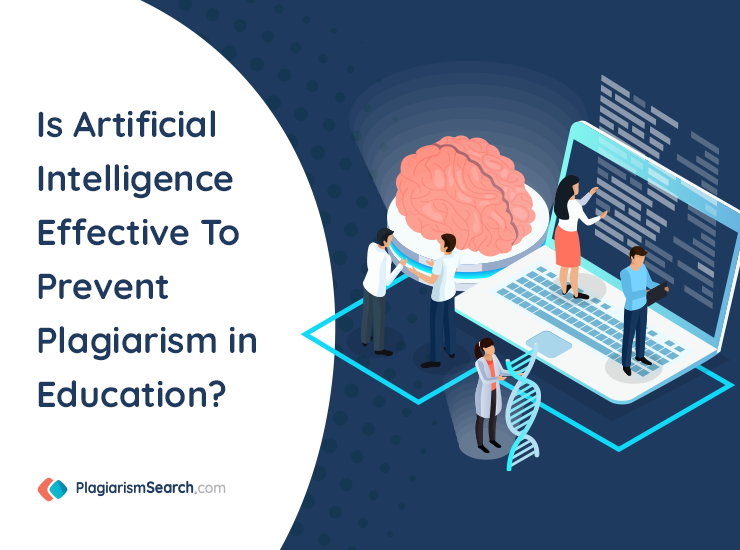
The Role of AI in Combatting Plagiarism
Plagiarism has become more widespread as access to original content online increases. The role of technology in plagiarism has become pivotal in preserving the integrity of education.
In This Article
What Are “Artificial Intelligence Plagiarism Checkers”?
Plagiarism Is On The Rise With Online Education
The Role Of Technology In Plagiarism
Using AI-Powered Plagiarism Checkers
How To Beat Plagiarism Checker
Benefits Of Using Artificial Intelligence To Prevent Plagiarism
There’s no denying that artificial intelligence significantly impacts nearly every aspect of our daily lives. That is especially the case for online education, as the use of technology in traditional education is rapidly increasing, with the global online education market forecast to reach $336.98 billion by 2026.
As artificial intelligence advances, more sophisticated tools for content creation are becoming accessible. These tools can improve the quality of academic content created or uploaded online, as well as safeguard against plagiarised material.
Plagiarism has always been a worrying aspect of content creation in education; oftentimes, it was impossible to know if a piece of content was 100% original. Now, that’s changing. AI-powered plagiarism checkers are radically transforming the way plagiarism is detected, allowing for more confidence in the integrity of original material.
Learn about the role that artificial intelligence plays in effectively preventing plagiarism in education.
What Are “Artificial Intelligence Plagiarism Checkers”?
“Plagiarism” refers to the unethical copying, disguising, use, and labeling of another’s original content or ideas as your own (without credit or reference to the original source). It occurs in respect of both physical and online content.
Plagiarism can be anything from copying large chunks of written material, to using someone else’s original idea without any citation.
Plagiarism isn’t just unethical, it can infringe on copyright laws and lead to the publishers facing serious consequences, including paying large fines or suspension from academic institutions and organizations.
There is also the case of unintentional plagiarism, where proper citation has not occurred.
Artificial intelligence plagiarism checkers are designed to scan content that is being created/uploaded online for any plagiarized content.
They use various word-matching algorithms to check for any instance where you’ve plagiarized. These algorithms effectively compare your content against all accessible content contained on the web. AI checks all word patterns and sequences and has different parameters that pinpoint whether the material has been copied and to what extent.
Despite various unethical manipulation techniques used to disguise plagiarized content, it’s virtually impossible to cheat modern anti-plagiarism software.
Plagiarism Is On The Rise With Online Education
The Covid-19 pandemic boosted online education because people were forced to change their learning interactions from physical and localized to remote online learning solutions. And while that forced institutions to implement new technology and solutions like VPNs to secure their computers, unfortunately, with the rise of online education also came a greater rise in plagiarism.
In traditional education (we’re talking physical books and papers), it’s harder to access multiple physical resources to copy. In the same breath, academic evaluators are unable to check submitted content against every single physical published resource available. Especially where content is plagiarized from a lesser-known source.
With the click of a button, you can now access seemingly countless resources online. There is also greater anonymity in the online learning arena, which can also be a potential reason why students may be more likely to plagiarise content. When people have the capability to create and send all material through online interfaces, the temptation to copy material may be greater.
Creating original content in online academia can get clouded by the overwhelming amount of original content available. As expressed, unintentional plagiarism is also something to be aware of, which is why plagiarism checkers aren’t just for evaluators to use, but also for students looking to ensure their work’s integrity.
The Role Of Technology In Plagiarism
Thankfully, with the advent of artificial intelligence plagiarism checkers, there’s an effective mechanism in place to curb plagiarism online. It’s important to preserve the quality of academic content produced and ensure that the accolades of those creating the material are rightly earned. Technology thus plays a vital role in the fight against plagiarism.
It’s incredible how AI technology has advanced over the years. This specialized technology enables computer systems and machines to have the ability to perform numerous tasks by simulating human intelligence.
AI-powered plagiarism checkers are designed to compare content online to check for copied material at a much larger scale, with greater speed, and more thoroughly than any human could.
Every piece of innovative technology goes through necessary iterations, and that’s true for AI checkers, too. Earlier versions of AI-powered plagiarism checkers were not as effective in detecting plagiarism. They may have wrongfully alerted plagiarized content when there actually wasn’t any plagiarism. At times, they also failed to detect actual plagiarized content.
However, AI-powered plagiarism checkers continually “learn” new vocabulary and sequences of words through their algorithms. These tools can also crawl more extensively through the web’s vast contents. It gets tougher to beat plagiarism checkers as time progresses.
There’s immense competition in academia. This makes it tempting for some to want to access, copy, and steal original content saved online by members of educational institutions.
Using AI-Powered Plagiarism Checkers
AI-powered plagiarism checkers conduct extensive comparison processes throughout the web’s contents. When plagiarized content is found, a report is received by the user detailing the plagiarism.
All academic content creators should have their content checked with a plagiarism checker. It’s essential to check academic content like articles and dissertations for plagiarism.
Plagiarism checkers are readily available and relatively easy to use. Users are usually required to create an account with an anti-plagiarism software provider. Thereafter, you can upload your content document onto the plagiarism checker’s dashboard for scanning. The scanning process is quick. You should have your plagiarism report in a few minutes.
Here’s a list of some of the more popular and credible plagiarism checkers on the market today:
Plagiarism checkers can check several types of content pieces online. Examples of some of these content pieces include:
- Advertisements
- Any online web content
- Articles
- Blog posts
- Business, product, or service descriptions
- Research and thesis documents
- White papers and guides
How To Beat Plagiarism Checker
You should always ensure that you don’t plagiarize any content from original resources used for your research, and any instances of referencing their content and ideas should be properly cited.
To ethically beat plagiarism checkers, it’s recommended that you use a plagiarism checker to screen your academic content before submitting it for grading or review. This way, you can address plagiarism issues in your content before professional academic evaluation.
Here are additional tips on how to beat plagiarism checker:
- Always use your own words and unique headings in your content.
- Use multiple resources to prevent focusing too much on a single piece of original content.
- When using online data, incorporate your own ideas or conclusions regarding the data in your writing.
- You could use AI text modification tools to modify your content that is being flagged as plagiarized. Be cautious when using these tools, as they may reduce the quality of your content, so extra editing may be needed.
- Credit any original resources used in your content. This includes using quotation marks and citations when including direct quotes from other sources.
- You can paraphrase words or sentences used from original sources. Be mindful of using correct grammar when paraphrasing.
Benefits Of Using Artificial Intelligence To Prevent Plagiarism
A great benefit of using artificial intelligence to prevent plagiarism is that students are taking more responsibility for checking their academic content for plagiarism. This has also led to better referencing of content used from other sources.
AI-powered plagiarism checkers have made online plagiarism detection more effective and efficient for both content creators and evaluators. We must acknowledge the place of artificial intelligence as an effective tool in fighting plagiarism in education.
Final Words For Thought
It’s important to protect the integrity of education by preventing plagiarism online. If you commit plagiarism in your academic content, there could be serious and devastating consequences to face. Don’t risk it!
Artificial intelligence is effective in preventing plagiarism in education. Most education institutions now use AI-powered plagiarism checkers to check academic content submitted.
Be conscientious about avoiding plagiarism when creating or uploading your content online. An AI-powered plagiarism checker should always be part of your “toolkit” to check your academic content.
Research Websites Used:
https://www.world-today-news.com/artificial-intelligence-against-educational-plagiarism/
https://www.scribbr.com/plagiarism/how-to-avoid-plagiarism/
https://www.quetext.com/blog/how-to-beat-a-plagiarism-checker-with-tips
https://www.analyticssteps.com/blogs/what-plagiarism-and-how-can-ai-tackle-it
